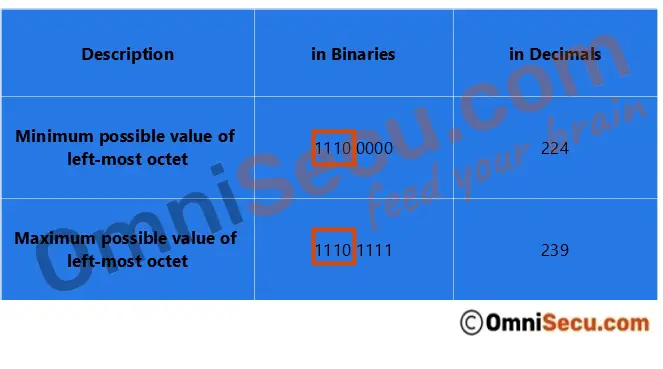Class D multicast IP addresses
Class D IPv4 addresses are known as multicast IPv4 addresses. Multicasting is a technique developed to send packets from one device to many other devices, without any unnecessary packet duplication. In other words, multicasting is "one-to-many" type of network communication. In multicast type of network traffic, a packet sent from a source is replicated as needed in the network to reach only to the end-users interested in that traffic. Users who are not interested in that traffic will not receive the copy of the packet. Network traffic sent to a multicast IPv4 address is usually meant for different interfaces on different computers on different network segments. You cannot assign Class D multicast IPv4 addresses to a network interface your computer.
Unicast IPv4 addresses (Class A, Class B and Class C IPv4 addresses) are used to identify a single interface. But multicast IPv4 addresses are used to identify a group of interfaces on different computers located in the same network segment or different network segments. A network interface can become member of many different multicast groups also.
I strongly suggest you to visit and learn below lessons before you continue learning more about Class D multicast IP addresses.
- IPv4 Addresses
- What is subnet mask
- What is network address
- Binary Decimal and Hexadecimal numbers and conversions
- Five layered TCP/IP model
- Network Layer (Layer 3)
- IPv4 Protocol, IPv4 header and fields of IPv4 header
- Media Access Control (MAC) addresses
- Limited broadcast address
- Directed broadcast address
- What is Loopback address
Multicast type of network communication is between a single sender and multiple receivers on a network. Data packets sent once from one computer is received by "many" receivers on a network. Note that the term used is "many", not "all". One-to-all type of communication is called as broadcast. Visit following links to learn more about two different types of broadcast communication in IPv4; limited broadcast and directed broadcast.
Four left-most bits of the left-most octet of a "Class D" network is reserved as "1110". The other 28 bits are used to identify the group of computers the multicast message is intended for. In other words, 28 bits after four most-significant bits "1110" in a multicast IPv4 address define the multicast group. Certain multicast addresses are reserved for for special uses.
Address range of Class D multicast IP addresses
Since the four left-most bits (also called as high-order bits or most-significant bits) of the first octet (left-most octet) of a Class D multicast IPv4 address are reserved as "1110", the 32 bits of a "Class D" address can be represented as 1110xxxx.xxxxxxxx.xxxxxxxx.xxxxxxxx.
Following image shows the range (minimum and maximum possible values) of left-most octet of a Class D multicast IP address. Note that four most-significant bits in left-most octet of a Class D multicast IP address are reserved as "1110". Most-significant bits in the left-most octet are marked inside an orange rectangle in below image.

The minimum possible value for the left-most octet in binaries is 11100000 (decimal equivalent is 224) and the maximum possible value for the left-most octet is 11101111 (decimal equivalent is 239). Therefore for a "Class D" multicast IPv4 address, left-most octet must have a value between 224 and 239 (224.0.0.0 to 239.255.255.255).
The minimum possible value for the left most octet in binaries is 11100000 (decimal equivalent is 224) and the maximum possible value for the leftmost octet is 11101111 (decimal equivalent is 239). Therefore for a "Class D" IPv4 address, leftmost octet must have a value between 224-239 (224.X.X.X to 239.X.X.X).
Please visit the following links in order to learn more about IPv4 multicast.
- What is multicast
- What is multicast group
- Multicast IPv4 address to MAC address mapping
- Comparison of multicast with unicast and broadcast
- Advantages and disadvantages of multicast
- How IPv4 multicast works on Ethernet
There is no concept of subnetting for Class D multicast IPv4 addresses. Since there is no subnetting for Class D multicast IPv4 addresses, they are considered as flat IPv4 addressing space. But there are many reservations in IPv4 Class D multicast addresses for specific purposes. Pleas read on.
IPv4 Class D multicast address reservations
ICANN (Internet Corporation for Assigned Names and Numbers) / Internet Assigned Number Authority (IANA) has reserved blocks of IPv4 Class D multicast address, for specific purposes. Following table shows IPv4 Class D multicast address block reservations.
| Reservations | Description |
|---|---|
| 224.0.0.0 to 224.0.0.255 | Local network control block (Link-local) |
| 224.0.1.0 to 224.0.1.255 | Internetwork control block |
| 224.0.2.0 to 224.0.255.255 | Ad hoc block I |
| 224.1.0.0 to 224.1.255.255 | Reserved |
| 224.2.0.0 to 224.2.255.255 | SDP (Session Description Protocol)/SAP (Session Announcement Protocol) address block |
| 224.3.0.0 to 224.4.255.255 | Ad hoc block II |
| 224.5.0.0 to 224.255.255.255 | Reserved |
| 225.0.0.0 to 231.255.255.255 | Reserved |
| 232.0.0.0 to 232.255.255.255 | Source Specific Multicast (SSM) block |
| 233.0.0.0 to 233.251.255.255 | GLOP address block |
| 233.252.0.0 to 233.255.255.255 | Ad hoc block III |
| 234.0.0.0 to 238.255.255.255 | Reserved |
| 239.0.0.0 to 239.255.255.255 | Administratively scoped address block |